Looking to create a peaceful and stylish living room? Japandi design might be just what you need.
This popular style blends Japanese and Scandinavian aesthetics to create spaces that are both beautiful and functional.
By combining minimalist furniture, neutral colors, and natural elements, you can transform your living room into a serene oasis that feels both modern and timeless.
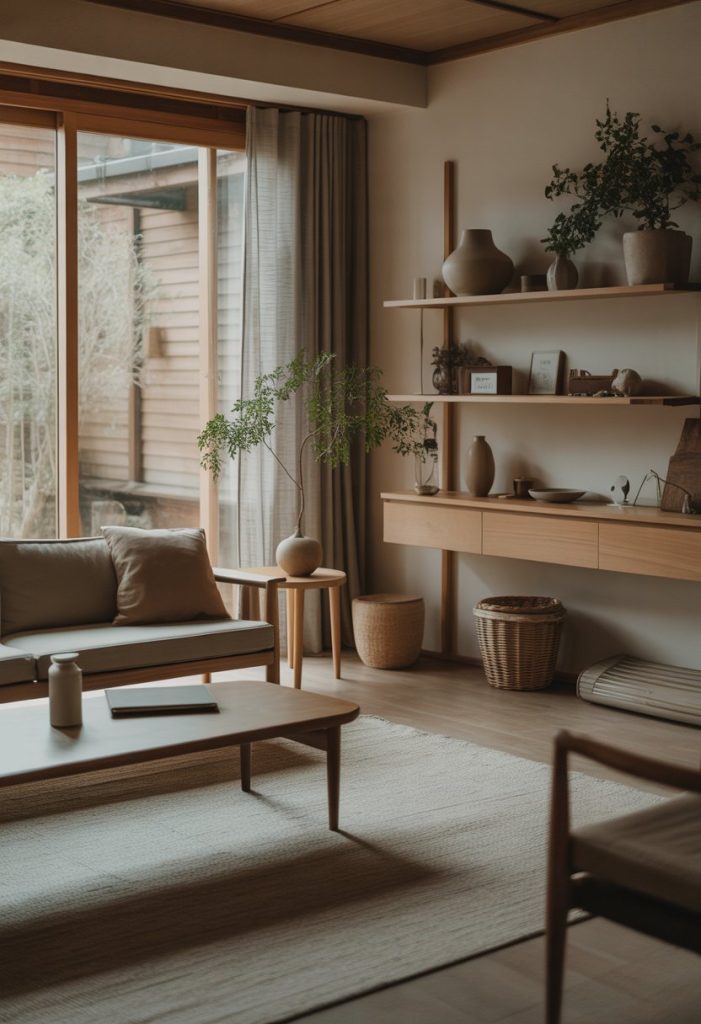
Japandi living rooms focus on simplicity, comfort, and harmony with nature. You’ll find warm wood tones, clean lines, and thoughtful arrangements that make the most of available space.
Whether you have a small apartment or a spacious home, these design ideas can help you create a living area that feels both cozy and uncluttered. It’s a perfect retreat from the busy outside world.
1. Use a neutral color palette with soft beiges and warm grays
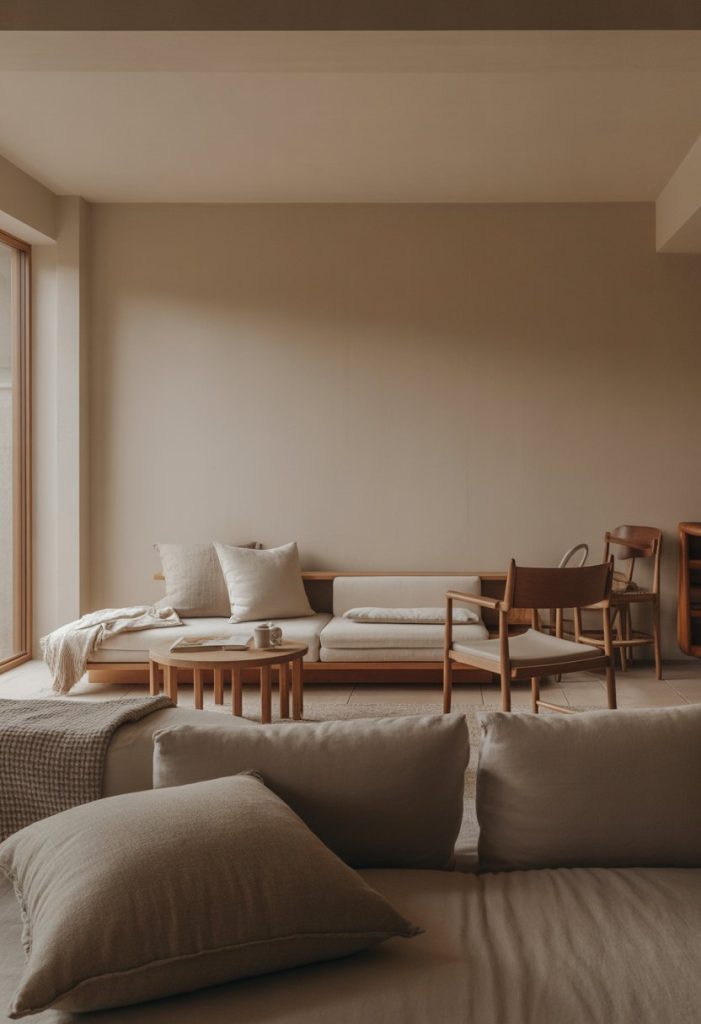
Japandi style really loves calm, neutral colors. You can create a peaceful living room with soft beiges and warm grays as your main colors.
These gentle tones work together to make a space that feels cozy and open. Ballet White, Gray Mist, Muslin, and Jute are great paint choices for your walls.
Add lots of natural light to bring out the warmth in these colors. This simple palette helps your room feel less cluttered and more peaceful.
2. Incorporate natural wood furniture with clean lines
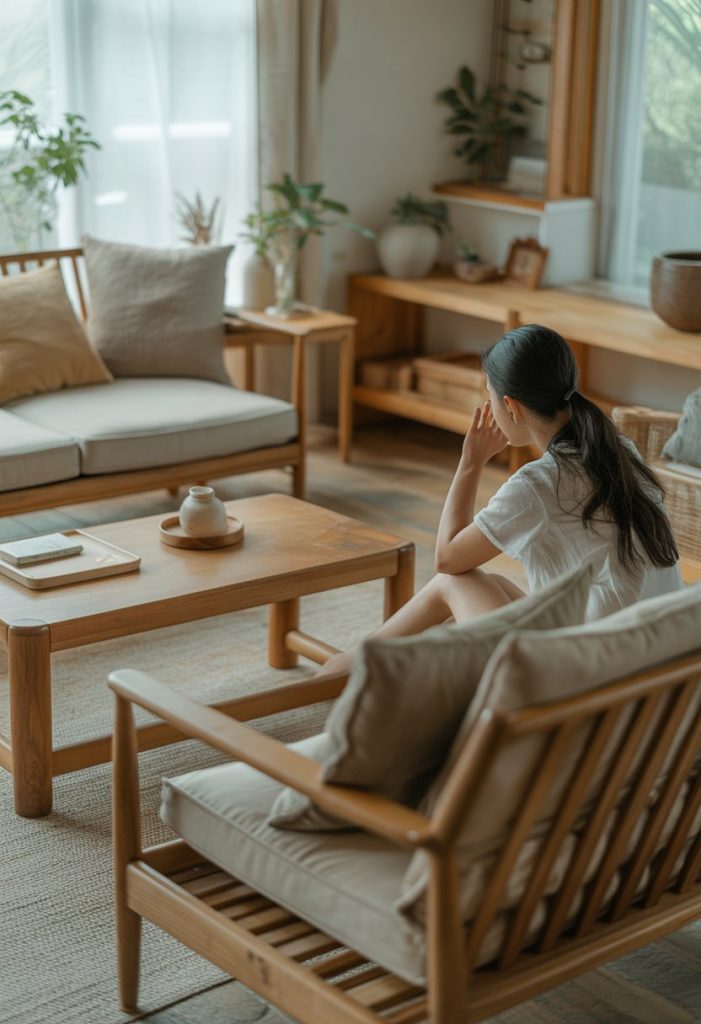
Natural wood furniture is a must in Japandi living rooms. Look for pieces with smooth, simple lines that show off the wood grain.
Oak, walnut, and maple work well for coffee tables, side tables, or dining sets. The warm tones of wood create a cozy feeling while keeping things minimal.
Try to pick pieces with thoughtful craftsmanship but not too much ornamentation. This balance honors both Japanese and Scandinavian design traditions.
3. Add Tatami mats for traditional Japanese texture

Tatami mats bring authentic Japanese tradition into your Japandi living room. These natural rice straw mats feel comfortable and look unique.
You can place tatami mats in a defined seating area or use them as flooring throughout the room. They add a wonderful texture and even a subtle, pleasant scent.
The natural materials fit perfectly with Japandi’s eco-friendly principles while grounding the design.
4. Choose low-profile seating like floor cushions or minimalist sofas

Low-profile seating sets the tone in Japandi living rooms. You can add floor cushions for a relaxed, Japanese-inspired vibe.
Minimalist sofas with wooden frames and neutral cushions blend comfort and style. These pieces sit close to the ground, creating a calm, grounded feeling.
Look for clean lines and natural materials in your seating choices. This approach honors both Japanese and Scandinavian design traditions.
5. Bring in plenty of natural light to open up the space
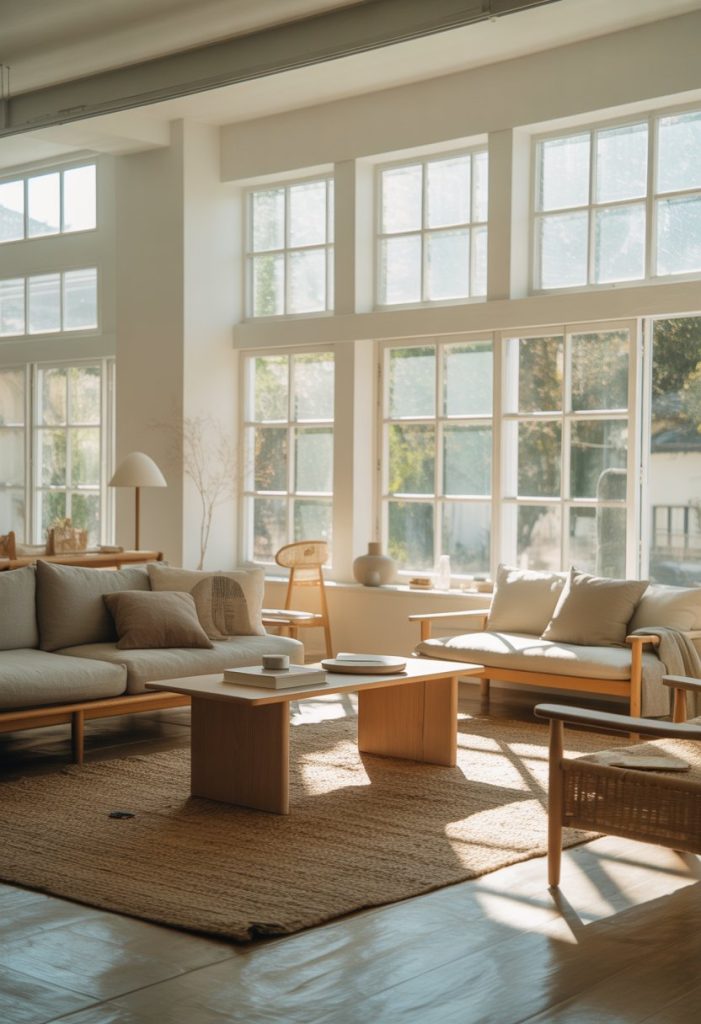
Natural light is huge in Japandi design. Large windows without heavy curtains let sunshine pour into your living room.
Try sheer curtains or bamboo blinds that filter light without blocking it completely. This creates that soft, peaceful ambiance everyone loves in Japandi spaces.
Place furniture to take advantage of light sources. Mirrors can help bounce light around and make your room feel more open.
6. Keep the room clutter-free to maintain simplicity
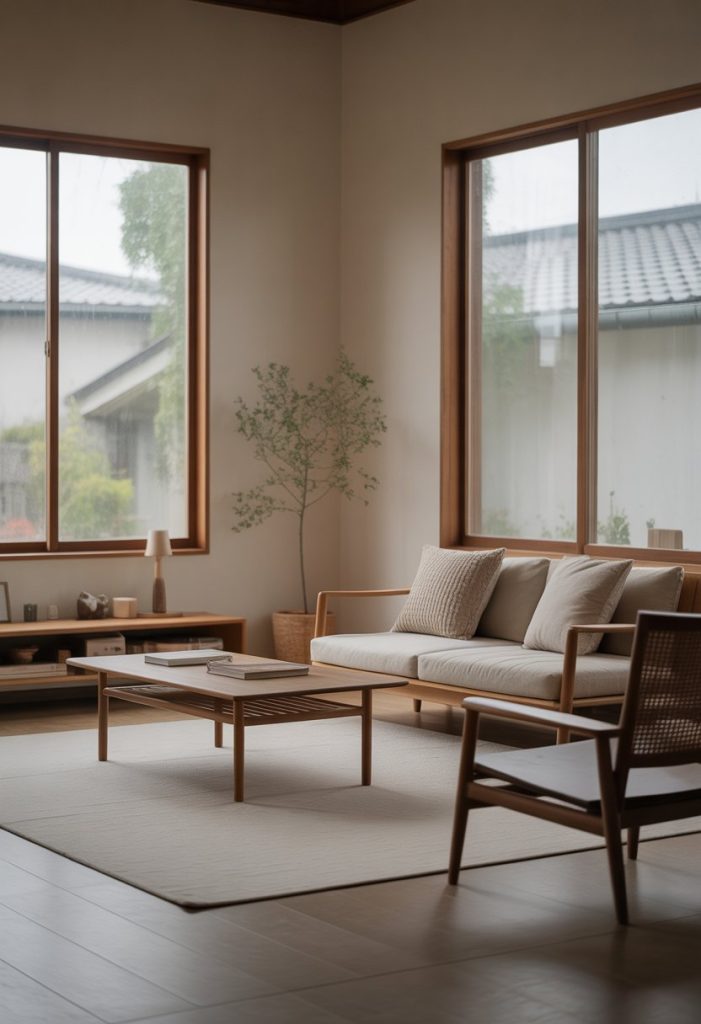
Japandi design really thrives on clean, uncluttered spaces. Try to keep only the essentials in your living room.
Remove knickknacks from coffee tables and shelves if they don’t serve a purpose. Choose furniture with built-in storage to hide away items you don’t need every day.
When decorating, remember that empty space matters just as much as the things you display. This balance helps create the calm, serene environment that makes Japandi spaces so inviting.
7. Use paper or fabric lampshades for soft, diffused lighting
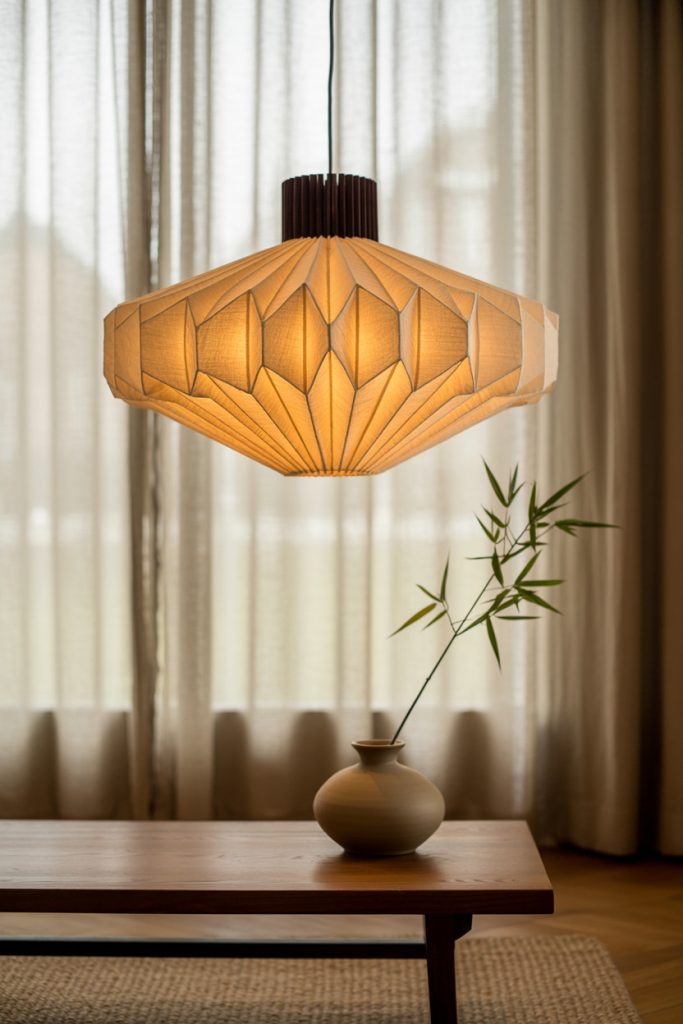
Lighting really shapes the mood in a Japandi living room. Paper lanterns and fabric lampshades give off a warm, gentle glow that feels cozy and sophisticated.
Hang paper lanterns from the ceiling or pick table lamps with fabric shades. These materials filter light beautifully, creating soft shadows and a peaceful vibe.
Natural materials like rice paper, linen, or bamboo work perfectly with Japandi style and add warmth to your space.
8. Include indoor plants like bonsai or fiddle leaf figs
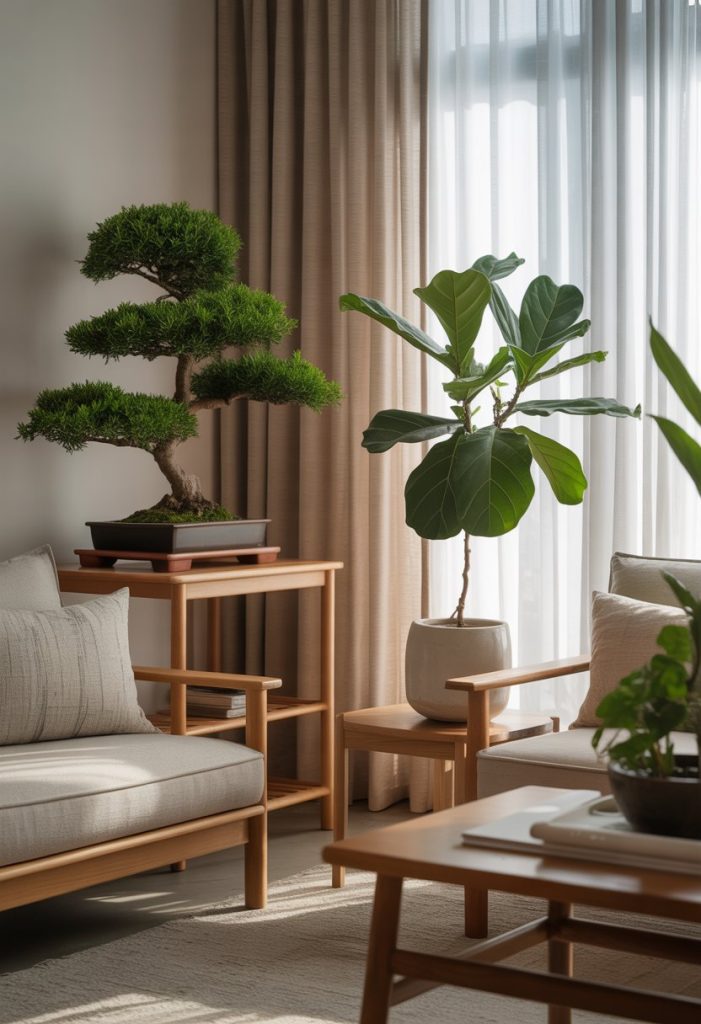
Plants bring life to your Japandi living room and help you connect with nature. Bonsai trees add a touch of Japanese tradition with their miniature elegance.
Fiddle leaf figs work great too, their big leaves making a bold statement. Peace lilies, maple trees, or Japanese aralia are also lovely choices.
Place taller plants in corners and smaller ones on coffee tables. This simple green touch helps create the calm, balanced environment that Japandi style celebrates.
9. Mix Scandinavian textiles such as wool throws with Japanese linen
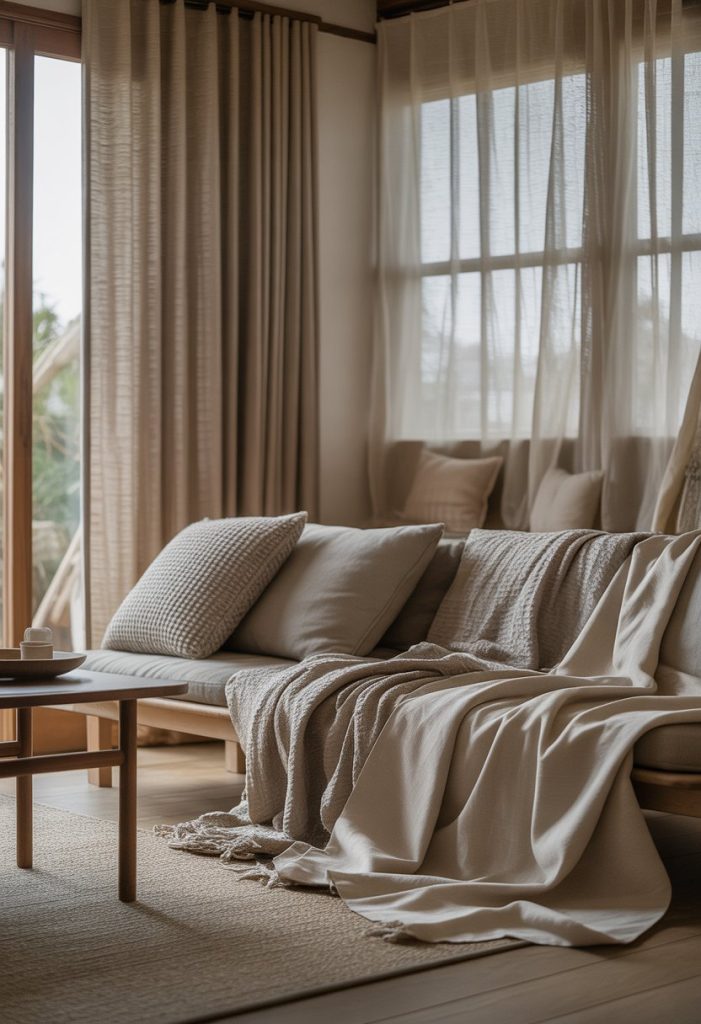
Blending textiles from both design traditions creates a cozy yet refined Japandi space. Try layering a chunky wool throw from Scandinavia over a chair with Japanese linen cushions.
The contrast between heavier Nordic textiles and lighter Japanese fabrics adds visual interest while keeping harmony. You might add a simple linen table runner or cotton-linen blend curtains for a soft, natural feel.
Stick with neutral and earthy colors to keep that peaceful Japandi atmosphere.
10. Select minimalist coffee tables in warm wood tones

A Japandi coffee table brings simplicity and elegance to your living room. Look for pieces with clean lines and minimal details in warm wood tones like oak, walnut, or teak.
Pick rectangular designs with legs that extend from the table’s underside for that distinctive Japandi look. These tables blend Japanese minimalism with Scandinavian warmth perfectly.
Your coffee table should be functional but understated, becoming a subtle focal point that ties the room together.
11. Add subtle textural contrast with woven baskets or ceramic vases
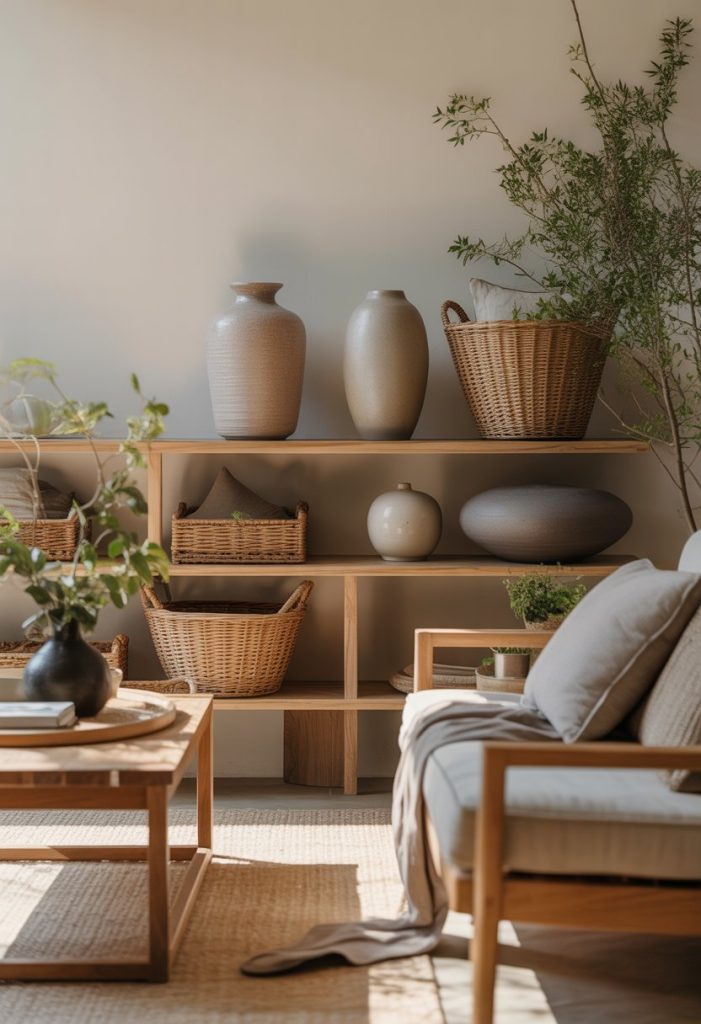
Woven baskets add wonderful texture to your Japandi living room. They bring warmth while fitting the natural aesthetic.
You can choose baskets with darker rims for subtle contrast. Round or cylindrical shapes balance the clean lines of Japandi furniture.
Handmade ceramic vases are another great option. Their imperfect, artisanal quality adds character while keeping things simple.
12. Focus on sustainability with eco-friendly materials
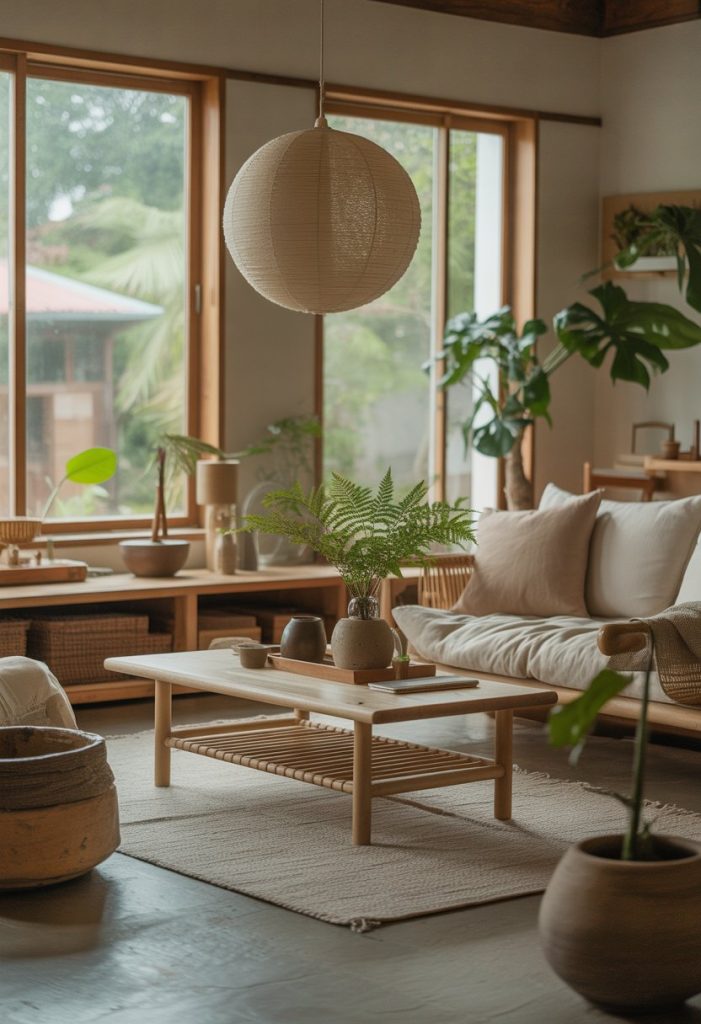
Japandi style really embraces sustainability. Use eco-friendly materials like bamboo, cork, and certified sustainable wood for your furniture and decor.
Natural fibers such as linen, cotton, and hemp make great picks for curtains, throw pillows, and rugs. They look beautiful and help reduce your environmental footprint.
Add indoor plants to purify the air and bring nature indoors. Choose locally-made ceramics and handcrafted items to support artisans and sustainable practices.
13. Place a simple tree or branch arrangement as a centerpiece
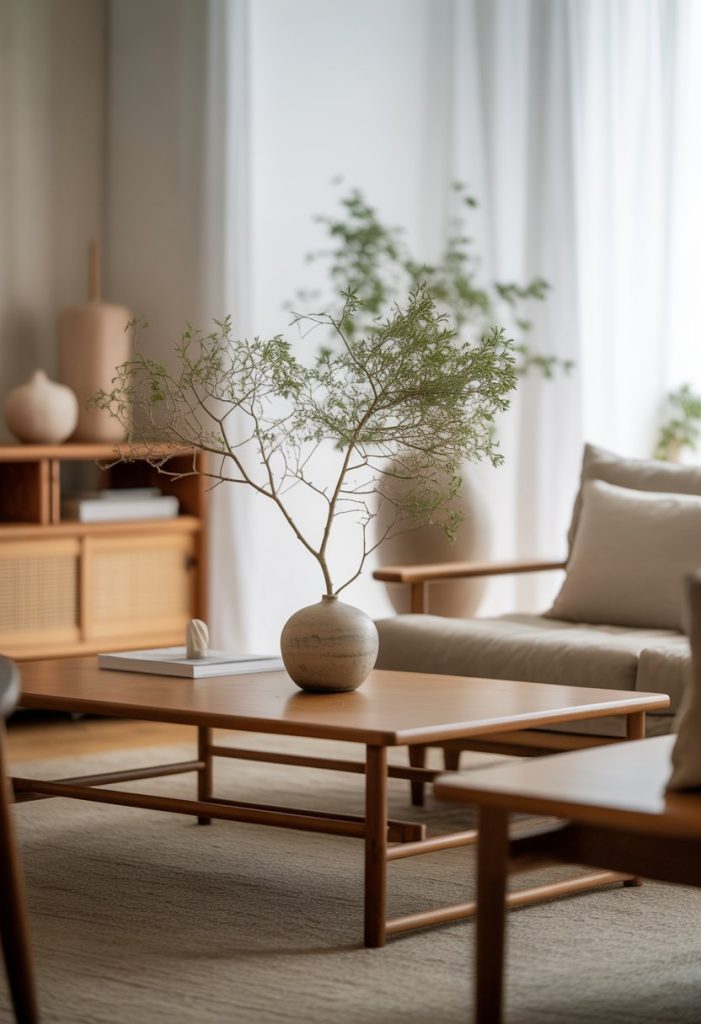
A tree branch centerpiece brings natural elegance to your Japandi living room. Arrange bare branches in a tall floor vase for a striking focal point.
You can also use smaller branches of juniper, cedar, or pine in a simple vase on your coffee table. Dried flowers or weeping fig branches work beautifully too, connecting your space to nature without fuss or clutter.
14. Opt for built-in storage to hide away everyday items

Built-in shelving works perfectly in Japandi living rooms. You can tuck away clutter while keeping clean lines in your space.
Try cabinets with hidden handles that blend into the walls. This creates a seamless look that feels calming and organized.
Pull-out organizers also help. They keep your necessities within reach but invisible when you’re not using them.
15. Use sliding shoji screens as room dividers or window treatments
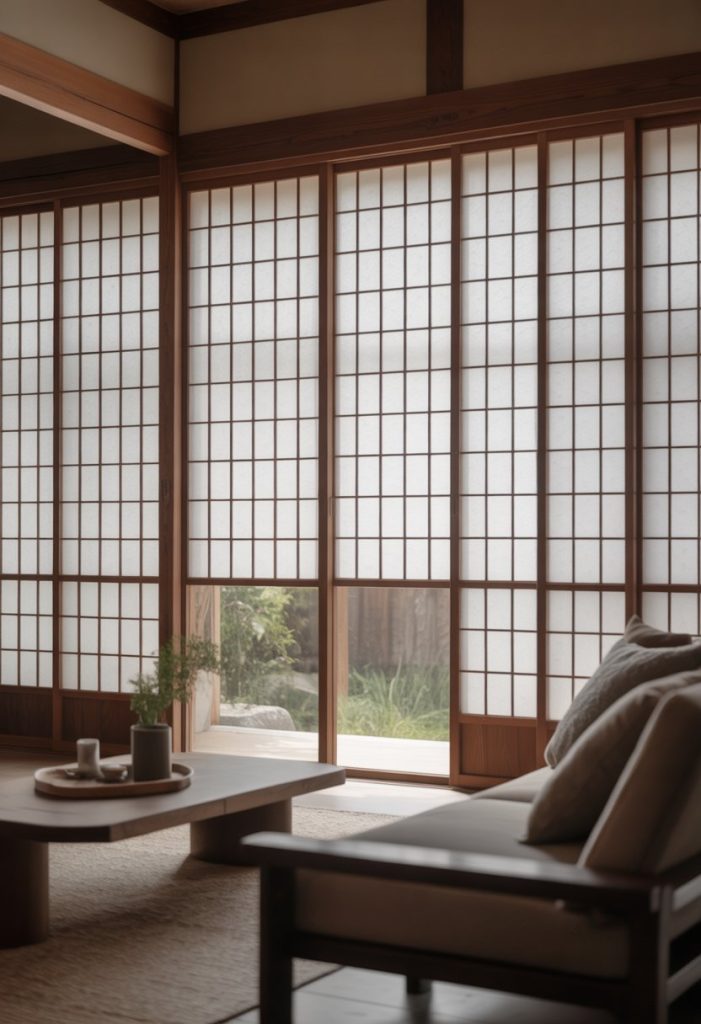
Sliding shoji screens add a unique Japanese touch to your Japandi living room. Use these paper or fabric panels as stylish room dividers to create separate spaces when you need them.
You can also use them as window coverings or closet doors. They filter light beautifully while keeping your privacy, and they add warmth and texture to your space.
16. Decorate with handcrafted pottery or minimalist ceramics
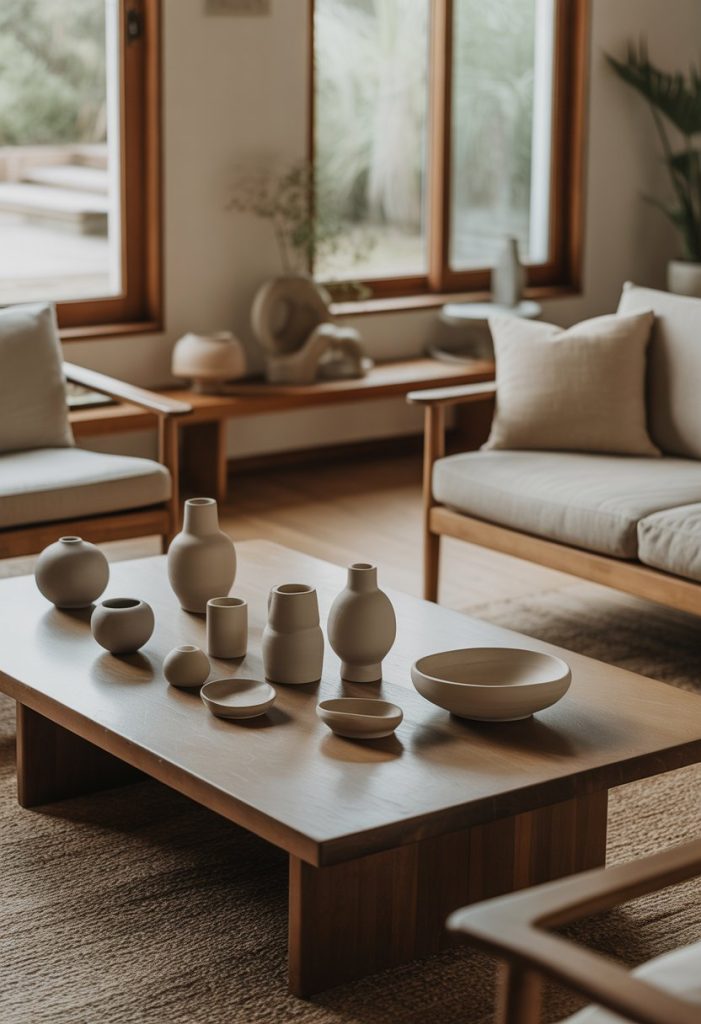
Handcrafted pottery brings warmth and character to a Japandi living room. I love pieces with organic shapes and earthy glazes that highlight those beautiful little imperfections.
Try placing a couple of ceramic vessels on your wooden tables or shelves. They add texture and that unmistakable human touch without making things feel cluttered.
You really don’t need a big collection—just one or two handmade items can steal the show. They’ll nod to both Japanese and Scandinavian love for craftsmanship.
17. Choose furniture with tapered wooden legs typical of Scandinavian style
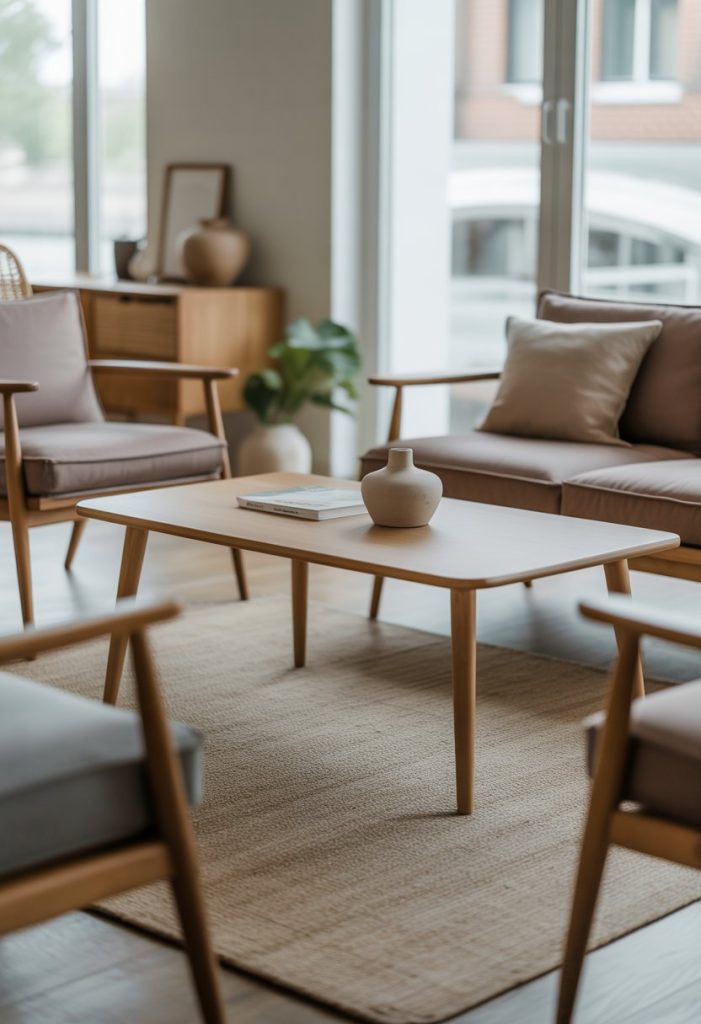
Tapered wooden legs scream Scandinavian design and fit right in with Japandi spaces. Look for coffee tables, chairs, or sofas with those slender, angled legs.
They give your living room a light, airy vibe and show off the beauty of natural wood. Plus, lifting furniture off the floor helps small spaces feel a bit bigger.
18. Incorporate a cozy wool rug in a muted pattern

A wool rug with a subtle pattern can totally transform your Japandi living room. These natural fiber rugs add warmth but still keep things clean and minimal.
Pick muted colors like beige, soft gray, or pale blue. Simple geometric or abstract patterns add just the right amount of visual interest.
Wool’s natural texture brings a cozy comfort, especially when it’s chilly out. The rug softens the room but doesn’t mess with that uncluttered Japandi vibe.
19. Add a Nelson bubble pendant lamp for a Japandi lighting accent

Nelson bubble pendant lamps are spot-on for a Japandi living room. These iconic lights mix soft curves with clean lines, working beautifully with both Japanese and Scandinavian details.
The paper shade adds texture and a bit of warmth but keeps things minimal. Hang one over your dining table or a cozy seating area—it makes a great focal point.
20. Embrace empty space to enhance room calmness
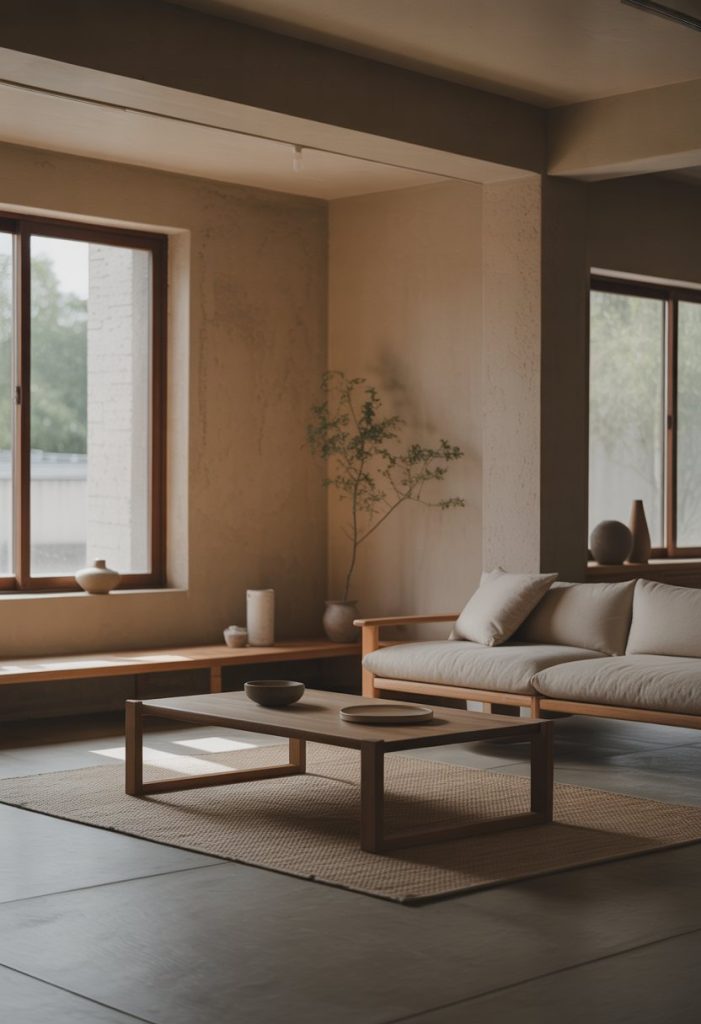
Empty space sits at the heart of Japandi design. You really don’t need to cram every corner of your living room with stuff.
Let a few spots breathe—just leave them open. That openness feels good and lets your mind settle down when you walk in.
In Japandi style, less goes a long way. Empty areas actually draw attention to the pieces you’ve picked and bring out a calm vibe.
